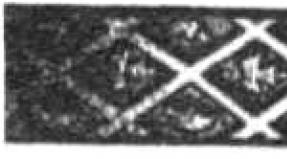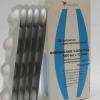The blood supply to the external female genital organs is carried out by branches. Female genital organs: blood supply, innervation, topography, structure. Blood supply to the external and internal genital organs
Blood supply to the internal genital organs It is carried out mainly from the aorta (the system of the common and internal iliac arteries). Main uterine blood supply ensured uterine artery (a uterina), which departs from the internal iliac (hypogastric) artery (a iliaca interna). In about half of the cases, the uterine artery independently departs from the internal iliac artery, but it can also originate from the umbilical, internal pudendal and superficial cystic arteries.
Uterine artery goes down to the lateral pelvic wall, then passes forward and medially, located above the ureter, to which it can give an independent branch. At the base of the broad uterine ligament, it turns medially towards the cervix. In the parametrium, the artery connects with the accompanying veins, nerves, ureter, and cardinal ligament. The uterine artery approaches the cervix and supplies it with the help of several tortuous penetrating branches. The uterine artery then divides into one large, very tortuous ascending branch and one or more small descending branches that supply the upper part of the vagina and the adjacent part. Bladder. The main ascending branch goes up along the lateral edge of the uterus, sending arcuate branches to her body. These arcuate arteries surround the uterus under the serosa. At certain intervals, radial branches depart from them, which penetrate into the intertwining muscle fibers of the myometrium. After childbirth, the muscle fibers contract and, acting like ligatures, compress the radial branches. The arcuate arteries rapidly decrease in size towards the midline, so there is less bleeding with median incisions of the uterus than with lateral ones. The ascending branch of the uterine artery approaches the fallopian tube, turning laterally in its upper part, and divides into tubal and ovarian branches. The tubal branch runs laterally in the mesentery of the fallopian tube (mesosalpinx). The ovarian branch goes to the mesentery of the ovary (mesovarium), where it anastomoses with the ovarian artery, which originates directly from the aorta.
The ovaries are supplied with blood from ovarian artery (a.ovarica) extending from the abdominal aorta on the left, sometimes from the renal artery (a.renalis). Going down along with the ureter, the ovarian artery passes along the ligament that suspends the ovary to the upper section of the wide uterine ligament, gives off a branch for the ovary and tube; the terminal section of the ovarian artery anastomoses with the terminal section of the uterine artery.
IN blood supply to the vagina, in addition to the uterine and genital arteries, the branches of the inferior vesical and middle rectal arteries are also involved. The arteries of the genital organs are accompanied by corresponding veins. The venous system of the genital organs is highly developed; the total length of the venous vessels significantly exceeds the length of the arteries due to the presence of venous plexuses, widely anastomosing with each other. The venous plexuses are located in the clitoris, at the edges of the bulbs of the vestibule, around the bladder, between the uterus and ovaries. IN innervation of the genital organs of a woman involved the sympathetic and parasympathetic parts of the autonomic nervous system and spinal nerves.
The fibers of the sympathetic part of the autonomic nervous system, which innervate the genital organs, originate from the aortic and celiac ("solar") plexuses, go down and form at the level of the fifth lumbar vertebra superior hypogastric plexus. It gives off fibers that form right and left lower hypogastric plexuses (plexus hypogastrics sinister et dexter inferior). Nerve fibers from these plexuses go to a powerful uterovaginal, or pelvic, plexus (plexus uterovaginal, s.pelvicus).
Uterovaginal plexus are located in the parametric fiber on the side and behind the uterus at the level of the internal os and cervical canal. Branches approach this plexus pelvic nerve (n.pelvicus) related to the parasympathetic part of the autonomic nervous system. Sympathetic and parasympathetic fibers extending from the uterovaginal plexus innervate the vagina, uterus, internal sections of the fallopian tubes, and the bladder. The ovaries are innervated sympathetic and parasympathetic nerves from the ovarian plexus (plexus ovaricus).
Blood supply to the external genitalia
are supplied with blood from these arteries: internal genital (a. pudenda interna), which departs from the internal iliac artery (a. iliaca interna) external genital (a. pudenda externa), which starts from the stem artery and rises medially from the outer ring of the axillary canal; obturator (a. obturatoria), emanating from the internal iliac artery; external seminal (a. spermatica externa) - branches of the external iliac artery (a. iliaca externa). The veins run parallel to the arteries.
Blood supply to the internal genital organs It is carried out mainly due to the uterine arteries extending from the internal iliac arteries and the ovarian arteries, which extend from the aorta.
The uterine arteries approach the uterus at the level of the internal os, are divided into descending branches (provide blood to the neck and upper part of the vagina) and ascending branches that rise along the ribs of the uterus, give transverse additional branches for the myometrium, branches for the broad and round ligaments, fallopian tube and ovary.
The ovarian arteries provide blood supply to the ovaries, fallopian tubes and upper uterus (anastamoses are developed between the uterine and ovarian arteries).
The blood supply of the fallopian tubes is carried out due to the branches of the uterine and ovarian arteries, which correspond to similar veins. The venous plexuses are located in the area of the mesosalpings and the round uterine ligament.
Top part The vagina is nourished by branches of the uterine arteries and vaginal arteries. The middle part of the vagina is supplied with blood by branches of the internal iliac arteries (lower cystic arteries, middle rectal artery). The lower part of the vagina also receives blood supply from the middle rectal artery and from the internal pudendal arteries.
Venous outflow is carried out along the veins of the same name, which form plexuses in the thickness of the broad ligaments between the uterus and ovaries and between the bladder and vagina.
Lymph drainage from the lower part of the vagina goes to the inguinal nodes. From the upper parts of the vagina, cervix and lower segment of the uterus, lymph goes to the sacral, obturator, external and internal iliac nodes, pararectal and pararectal lymph nodes. From the upper body of the uterus, lymph is collected in the para-aortic and para-renal lymph nodes. The outflow of lymph from the fallopian tubes and ovaries occurs in the periovarian and para-aortic lymph nodes.
The innervation of the internal genital organs is carried out from the nerve plexuses located in abdominal cavity and small pelvis: upper hypogastric, lower hypogastric (pelvic), vaginal, ovarian. The body of the uterus receives predominantly sympathetic fibers, the cervix and vagina receive parasympathetic fibers. The innervation of the fallopian tubes is carried out by the parasympathetic and sympathetic divisions of the autonomic nervous system from the uterovaginal, ovarian plexuses and fibers of the external spermatic nerve.
Pregnancy-induced edema and proteinuria without hypertension. Clinic, diagnosis, treatment, prevention.
Indications for early amniotomy. Execution technique.
Amniotomy.
This is an opening of the fetal bladder. Produced by branches from bullet tongs.
Effects:
Reducing the volume of the uterine cavity increased labor activity.
Violation of the integrity of the fetal bladder leads to the release of PG and increased labor activity.
Removal of the anterior waters in order to enhance labor activity.
GHGs provide antispasmodic effect which leads to a decrease in blood pressure.
Mechanical compression of the lower pole of the low-lying placenta.
Decreased intrauterine volume in PONRP.
Indications for early amniotomy:
hypertension
Gestosis of any degree
Weak labor activity
Flat amniotic sac (anterior water column less than 2 cm)
Low placentation
PONRP, as an aid before CS, in order to prevent the uterus of Kuveler
Age primiparous
Polyhydramnios
Multiple pregnancy prevention of overstretching of the uterus
large fruit
oligohydramnios
Extragenital pathology
Read also:
|
The sympathetic and parasympathetic nervous systems, as well as the spinal nerves, participate in the innervation of the genital organs.
The fibers of the sympathetic nervous system that innervate the genitals originate from the aortic and solar plexus, go down and form the superior epigastric plexus at the level of the 5th lumbar vertebra. Fibers depart from the specified texture, a cat. go down and to the sides and form the right and left lower hypogastric plexuses.
Nerve fibers from these plexuses are sent to a powerful uterovaginal plexus (pelvic plexus). The uterovaginal plexus is located in the parametric fiber, on the side and posterior to the uterus, at the level of the internal os of the cervical canal. Branches of the pelvic nerve related to the parasympathetic nervous system approach this plexus. Sympathetic and parasympathetic nerve fibers extending from the uterovaginal plexus innervate the vagina, uterus, internal sections of the fallopian tubes, and the bladder. The body of the uterus is innervated mainly by sympathetic fibers, and the cervix and vagina are predominantly parasympathetic.
The ovary is innervated by sympathetic and parasympathetic nerves from the ovarian plexus. Nerve fibers from the aortic and renal plexus approach the ovarian plexus.
The external genital organs are innervated mainly by the pudendal nerve.
Thus, the nerves of the internal genital organs are connected through the aortic, renal, and other plexuses with the nerves internal organs.
In the walls of the uterus, tubes and in the medulla of the ovary, thick nerve plexuses. The thinnest nerve branches extending from these plexuses are sent to muscle fibers, the integumentary epithelium, and all other cellular elements. In the mucous membrane of the uterus, the terminal nerve branches also go to the glands, in the ovary - to the follicles and corpus luteum. The thinnest terminal nerve fibers end in the form of buttons, cones, and so on. These nerve endings perceive chemical, mechanical, thermal, and other stimuli.
The nerve endings of the internal genital organs are interoreceptors, the cat. perceive irritations from internal organs. Irritations perceived by sensitive nerve endings are transmitted along the nerve fibers to the higher parts of the nervous system, where the centers that regulate the activity of the internal genital organs are located. Impulses from these centers are transmitted along the motor secretory nerve fibers to the genital organs and direct their activity (muscle contraction, gland secretion, hormone production, etc.). The nerve centers that regulate the activity of the genital organs are located at different levels of the central nervous system.
Efferent parasympathetic fibers start from the lateral horns of the S II–S IV segments spinal cord(erection center), repeat the ways of regulating urination (the second neuron is located in the plexus prostate) - pelvic splanchnic nerves (nn. splanchnici pelvini), or excitatory nerves (nn. erigentis) cause vasodilatation of the cavernous bodies of the penis, pudendal nerves (nn. pudendi) innervate the sphincter of the urethra, as well as the sciatic-cavernous and bulbous-spongy muscles (mm. ishiocavernosi, mm. bulbospongiosi)(Fig. 12.13).
Efferent sympathetic fibers begin in the lateral horns L I -L II (ejaculation center) of the segments of the spinal cord and through the anterior roots, the nodes of the sympathetic trunk, interrupted in the hypogastric plexus, reach the seminal ducts, seminal vesicles and the prostate gland along the paravascular branches of the hypogastric plexus.
The reproductive centers are partly under neurogenic influence, realized through the reticulospinal fibers, partly under the humoral influence from the higher hypothalamic centers (Fig. 12.13).
According to Krucke (1948), the posterior longitudinal fasciculus (fasciculus longitudinalis dorsalis), or the bundle of Schutz, has a continuation in the form of an unmyelinated parepindemic bundle (fasciculus parependimalis), descending on both sides of the central channel to sacral department spinal cord. It is believed that this path connects the diencephalic genital centers, located in the region of the gray tubercle, with the sexual center of the lumbosacral localization.
Bilateral damage to the sacral parasympathetic center leads to impotence. Bilateral damage to the lumbar sympathetic center is manifested by a violation of ejaculation (retrograde ejaculation), testicular atrophy is observed. With a transverse injury of the spinal cord at the level of the thoracic region, impotence occurs, which can be combined with reflex priapism and involuntary ejaculation. Focal lesions of the hypothalamus lead to a decrease in sexual desire, weakening of erection, delayed ejaculation. The pathology of the hippocampus and limbic gyrus is manifested by a weakening of all phases of the sexual cycle or complete impotence. During right hemispheric processes, sexual stimuli fade, unconditional reflex reactions weaken, the emotional sexual attitude is lost, and libido weakens. With the left hemispheric processes, the conditioned reflex component of the libido and the erectile phase are weakened.
Violations of sexual function and its components can be induced a wide range diseases, but in most cases (up to 90%) are associated with psychological causes.
Peripheral autonomic syndromes
Syndrome of peripheral autonomic failure occurs when postganglionic vegetative fibers are damaged in patients with polyneuropathy various etiologies. In the pathogenesis of the syndrome, a decisive role is played by a violation of the release of norepinephrine by sympathetic fibers and acetylcholine by parasympathetic fibers. Symptoms are manifested by a picture of loss of function of sympathetic or parasympathetic fibers, or a combination of them. The leading signs are orthostatic hypotension, resting tachycardia, fixed pulse, arterial hypertension in the supine position, hypo- or anhidrosis, impotence, dysmotility gastrointestinal tract(constipation or diarrhea), urinary retention or incontinence, reduced twilight vision, sleep apnea. There are primary peripheral autonomic insufficiency associated with a primary lesion of the ANS (Bradbury-Eggleston, Riley-Day syndromes) and secondary, caused by diseases of the spinal cord and damage to the peripheral nervous system. The latter is due to systemic, autoimmune and infectious diseases, exo- and endotoxic factors.
Bradbury–Eggleston syndrome (pure autonomic dysfunction, idiopathic orthostatic hypotension) is a degenerative disease of the ANS in which both the sympathetic and parasympathetic divisions of the autonomic nervous system are affected, but the structures and functions of the CNS, as a rule, remain intact. Clinically, the disease is manifested by peripheral autonomic failure. In the blood, there is a significant decrease in the content of norepinephrine (up to 10% of the norm and below).
Riley-Day syndrome due to a congenital disorder mainly in the peripheral parts of the ANS and is manifested by reduced lacrimation, impaired thermoregulation, orthostatic hypotension, episodes severe vomiting. The disease has an autosomal recessive mode of inheritance.
Shaye-Dreijer syndrome (multiple system atrophy). Severe autonomic failure is combined with cerebellar, extrapyramidal and pyramidal insufficiency. Character clinical manifestations depends on the degree of involvement of these systems in the pathological process. The syndrome is manifested by orthostatic hypotension, parkinsonism, impotence, impaired pupillary reactions, urinary incontinence. The autonomic system remains almost intact, but the nature of the CNS lesion is such that it causes disturbances in the regulatory functions of the autonomic nervous system.
Winterbauer syndrome It usually manifests itself in women over 20 years of age with telangiectasias, skin calcification, acrocyanosis, increased sensitivity to cold, sclerodactyly, recurrent ulcerations, degeneration of the terminal phalanges, leading to deformities of the hands and feet.
Causalgic syndrome (Pirogov-Mitchell disease).
Characterized by intense pain due to irritation of the autonomic structures of peripheral nerves. It is more common in traumatic lesions of the median, sciatic and tibial nerves, which contain a large number of sympathetic fibers. Characterized by a sharp, burning, difficult to localize, widely radiating pain, the intensity of which is somewhat facilitated by wetting the skin with cold water or wrapping a limb soaked in cold water cloth. Vegetative pain in this case can be provoked by external influences (touch, sharp sound stimuli, etc.). In the zone of innervation of the affected nerve, permanent hyperpathy, vascular, and often trophic disorders are detected.
Charcot-Grasset syndrome. Characterized by vegetative-vascular and trophic disorders in the legs, mainly in distal parts manifested by cyanosis, edema, sympathalgia.
12.2.3. Metasympathetic division of the autonomic nervous system
A complex of microganglionic formations located in the walls of internal organs that have motor activity (heart, intestines, ureter, etc.) and ensure their autonomy. The function of nerve nodes is, on the one hand, in the transmission of central (sympathetic, parasympathetic) influences to the tissues, and on the other hand, in ensuring the integration of information coming through local reflex arcs. They are independent entities capable of functioning with full decentralization. Several (5–7) nearby nodes are combined into a single functional module, the main units of which are oscillator cells that ensure the autonomy of the system, interneurons, motor neurons, and sensory cells. Separate functional modules make up a plexus, thanks to which, for example, in the intestine, a peristaltic wave is organized.
The activity of the metasympathetic division of the ANS does not depend on the activity of the sympathetic or parasympathetic nervous system, but can change under their influence. So, for example, activation of parasympathetic influence enhances intestinal motility, and sympathetic influence weakens it.
A woman came to the family planning center for advice on contraception. 4 months ago there was an urgent normal first birth. Breastfeeds the baby, milk is enough. A week ago, within three days, the first menstruation after childbirth passed normally. Sexual life is regular, without contraception.
1 Does this patient require contraception?
2 What methods of postpartum contraception do you know? How do they affect lactation?
3 What method of contraception do you consider optimal for this patient?
4 What research should be done before use this method?
Answer to problem 96.
2. Lactational amenorrhea, ICH, voluntary surgical contraception, barrier methods, hormonal preparations. All of these methods, except for the use of COCs, do not reduce lactation.
4. Smears for gn and flora from the urethra and cervical canal.
III. Innervation of the female internal genital organs.
The sympathetic and parasympathetic nervous systems, as well as the spinal nerves, participate in the innervation of the genital organs.
The fibers of the sympathetic NS, innervating the genitals, originate from the aortic and solar plexuses, go down and form the superior hypogastric plexus at the level of the fifth lumbar vertebra. From this plexus fibers depart, which go down and to the sides and form the right and left lower hypogastric plexuses.
Nerve fibers from these plexuses are sent to a powerful uterovaginal plexus (pelvic plexus). The uterovaginal plexus is located in the parametric fiber, on the side and posterior to the uterus, at the level of the internal os of the cervical canal. Branches of the pelvic nerve related to the parasympathetic nervous system approach this plexus. Sympathetic and parasympathetic fibers extending from the uterovaginal plexus innervate the vagina, uterus, internal sections of the fallopian tubes, and the bladder. The body of the uterus is innervated mainly by sympathetic fibers, and the cervix and vagina are predominantly parasympathetic.
The ovary is innervated by sympathetic and parasympathetic nerves from the ovarian plexus. Nerve fibers from the aortic and renal plexuses approach the ovarian plexus.
The external genital organs are innervated mainly by the pudendal nerve.
Thus, the nerves of the internal genital organs are connected through the aortic, renal and other plexuses with the nerves of the internal organs.
Dense nerve plexuses form in the walls of the uterus, tubes and in the medulla of the ovary. The thinnest nerve branches extending from these plexuses are sent to muscle fibers, the integumentary epithelium and all other cellular elements. In the mucous membrane of the uterus, the terminal nerve branches also go to the glands, in the ovary - to the follicles and corpus luteum. The thinnest terminal nerve fibers end in the form of buttons, cones, etc. These nerve endings perceive chemical, mechanical, thermal and other stimuli.
The nerve endings of the internal genital organs are interoreceptors that perceive irritation from the internal organs. Irritations perceived by sensitive nerve endings are transmitted along the nerve fibers to the higher sections of the NS, where the centers that regulate the activity of the internal genital organs are located. Impulses from these centers are transmitted along the motor and secretory nerve fibers to the genital organs and direct their activity (muscle contraction, gland secretion, hormone production, etc.). The nerve centers that regulate the activity of the genital organs are located at different levels of the central nervous system.
IV. The lymphatic system of the reproductive organs.
The lymphatic system of the genital organs consists of a dense network of tortuous lymphatic vessels and many lymph nodes. Lymphatic tracts and nodes are located mainly along the blood vessels. Lymphatic vessels that drain lymph from the external genitalia and the lower third of the vagina go to the inguinal lymph nodes. The lymphatic pathways extending from the middle and upper third of the vagina and cervix go to the lymph nodes located along the hypogastric and iliac blood vessels.
From the body of the uterus, tubes and ovaries, lymph is discharged through the vessels located along the ovarian artery, and goes to the lymph nodes lying on the aorta and inferior vena cava.
There are anastomoses between these systems of the lymphatic ducts of the genital organs.
V. Ligament apparatus of the genital organs.
In the normal position, the uterus with tubes and ovaries is held by a suspension apparatus, a fixing apparatus and a supporting apparatus:
1) Hanging device:
Round ligaments (lig. rotundum) - depart from the corners of the uterus (slightly anterior and below the place where the tubes exit), go under the anterior leaf of the broad ligament to the internal openings of the inguinal canals. After passing through the inguinal canal, the round ligaments fan out and attach to the tissue of the pubis and labia majora. The round ligaments pull the fundus of the uterus anteriorly (anterior tilt). During pregnancy, the round ligaments thicken and lengthen;
Broad ligaments (lig. Latum) - double sheets of peritoneum, extending from the ribs of the uterus to the side walls of the pelvis. Pipes pass in the upper sections of the wide ligaments, ovaries are located in the posterior sheets, fiber is located between the sheets, as well as vessels and nerves;
The sacro-uterine ligaments (lig. sacrouterinum) depart from the posterior surface of the uterus in the area of the transition of the body to the neck, go backwards, cover the rectum on both sides and are attached to the anterior surface of the sacrum. These ligaments pull the cervix backwards. During childbirth, the round and sacro-uterine ligaments help hold the uterus in place;
Own ligaments of the ovaries (lig. ovarii proprium) start from the bottom of the uterus behind and below the place where the tubes exit and go to the ovaries;
Funnel-pelvic ligaments (lig. infundibulopelvicum)
Rectal-uterine muscles (mm. rectouteri)
2) The fixing apparatus of the uterus (retinaculum uteri) consists of connective tissue strands with a small number of muscle cells that come from the lower part of the uterus (a zone of fiber compaction):
To the side walls of the pelvis (main ligaments - lig. cardinale);
posteriorly, making up the connective tissue framework of the sacro-uterine ligaments.
3) The supporting apparatus consists of the muscles and fascia of the pelvic floor, which prevent the genitals and viscera from lowering down.
VI. Fiber of the small pelvis.
Under the peritoneal cover of the pelvic organs is the pelvic tissue, which is adjacent to the internal genital organs in different departments. Fiber fills all the free spaces between the pelvic organs in the part that is not covered by the peritoneum and is located above the pelvic fascia. In the loose pelvic tissue, areas are distinguished where dense fibrous tissue predominates. connective tissue. These areas of compaction constitute, in particular, the fixing apparatus of the internal genital organs.
In the pelvic tissue, the following departments are distinguished:
Periouterine (parametrical) fiber - occupies the space between the sheets of wide ligaments from the side walls of the pelvis;
Peripesical (paravesical) fiber;
Circumvaginal (paravaginal) fiber - surrounds the vagina, is located mainly in the space extending from the lateral sections of the vagina to the pelvic walls;
· Pararectal (pararectal) fiber - located around the rectum.
All of these sections of the pelvic tissue are not limited, but are connected to each other by numerous connective tissue elements.
The pelvic tissue has great importance. Loose fiber contributes to the physiological mobility and proper functioning of the internal genital organs, bladder and rectum, allows organs to change volume (filling and emptying the bladder and rectum, changing the size of the uterus due to pregnancy and childbirth, and more). Dense sections of the pelvic fiber fix the pelvic organs in a movable-suspended state, participate in keeping the uterus and other parts of the reproductive apparatus in a normal position. The fiber of the pelvis forms a bed for the ureters, blood and lymphatic vessels, lymph nodes, nerve trunks and plexuses.
II. MODERN CONCEPTS ABOUT THE NEURO-ENDOCRINE REGULATION OF THE MENSTRUAL CYCLE. PHASES OF THE MENTAL CYCLE.
See midwifery questions (section I, question 23).
III. DIAGNOSIS ALGORITHM, THE ROLE OF THE INTERVIEWING SYSTEM AND METHODS OF GENERAL AND SPECIAL INVESTIGATION IN THE DIAGNOSIS OF GYNECOLOGICAL DISEASES.
When examining gynecological patients, the following stages can be distinguished:
I. History taking:
1. Passport data - full name, age, profession, marital status, working and living conditions.
2. Complaints of the patient:
Pain, which in gynecological patients is very diverse in degree, nature of localization, time of occurrence, etc.:
Intensity pain is in connection with the characteristics of the nervous system, the emotional state of a woman, the degree of involvement in the pathological process of nerve endings, stretching of the visceral peritoneum, metabolic disorders in the focus of inflammation, with the specificity of the inflammatory process (with gonorrheal inflammation of the uterine appendages, the pain in the acute stage is intense and prolonged, with tuberculous inflammation, the pain can be relatively small, even with significant spread) and a number of other factors.
Growing, cramping, pulling, pressing;
Pain can occur in the lower abdomen (with diseases of the uterus), the lumbosacral region (with backward bending of the uterus - retroflexion), in the ilio-inguinal regions (with diseases of the uterine appendages);
Of great importance is the time of onset of pain. Pain that occurs regularly in the middle menstrual cycle may be associated with ovulation. The appearance of progressive pain in the second half of the cycle, continuing during the 1-2nd day of menstruation, is characteristic of endometriosis. Pain that occurs during intercourse is more often caused by a chronic inflammatory process of the uterine appendages or posterior cervical endometriosis;
Pain irradiation. The innervation of the uterus is in connection with the XI-XII thoracic and III-V sacral segments of the spinal cord, therefore, reflected pain in pathological changes in this organ appears in the lower back, lower back, sometimes in the hypogastric region. In diseases of the ovaries and fallopian tubes, pain is felt in the lower back, in the lumbar, inguinal and hypogastric regions;
Repercussion - a reflection of irritation from a less excitable area to a more excitable one, as a result of which pain can be felt in the area of \u200b\u200ba healthy organ associated with a common innervation with a pathological focus;
Violations of the function of the genital organs (menstrual, sexual, reproductive, secretory);
Violation of the function of organs associated with the genital organs in anatomical and functional terms ( urinary tract, rectum);
3. Heredity.
4. Past diseases.
5. Functions of the reproductive system:
· Menstrual function is the most important function of the reproductive system of a woman and indicates both the usefulness of the system itself and the health of the woman as a whole. When determining the features of menstrual function, it is necessary to pay attention to the following points:
ü At what age did the first menstruation appear and what was their nature;
ü After what period of time a regular menstrual cycle was established;
ü What is the duration of the cycle;
ü How many days does menstruation last and what is the amount of blood lost;
ü Changes in the menstrual cycle after the onset of sexual activity, abortion, childbirth, etc.;
ü Time of the last menstruation;
ü Changing the cycle in connection with this gynecological disease.
The main types of menstrual dysfunction:
ü Amenorrhea - absence of menstruation;
ü Hypomenstrual syndrome- weakening (hypomenorrhea), shortening (oligomenorrhea) and slowing down (opsomenorrhea) of menstruation;
ü Menorrhagia - bleeding associated with the menstrual cycle, which is cyclic in nature and is manifested by an increase in blood loss during menstruation (hypermenorrhea), a longer duration of menstrual bleeding (polymenorrhea) and disturbances (shortening) of their rhythm (proyomenorrhea);
ü Metrorrhagia - acyclic uterine bleeding not associated with the menstrual cycle;
ü Algodismenorrhea - painful menstruation.
Sexual function:
ü The presence of sexual desire (libido);
ü The presence of a sense of satisfaction (orgasm);
ü Violations of sexual function - pain during sexual intercourse, contact bleeding, difficulty or impossibility of sexual intercourse;
Reproductive function:
ü Time of onset of pregnancy after the onset of sexual activity;
ü Number of pregnancies, their course and outcomes;
ü Presence of complications of pregnancy, childbirth and postpartum period;
ü The number of abortions, at what time they were performed, were there any complications;
Secretory function is an important indicator of the state of the female genital organs. With many gynecological diseases, as well as in pathological processes that are not directly related to the reproductive system, there is a quantitative or qualitative change in the secret.
Beli - pathological discharge from the genital organs of a woman:
o Vestibular leucorrhea
o Vaginal leucorrhea
o Cervical leucorrhea
o Uterine leucorrhoea
o Tube whites.
6. Functions of organs associated with the genital organs in anatomical and functional terms:
· Urinary system
· Rectum.
7. History of present illness, which is analyzed in chronological order.
As a result of a detailed survey of the patient, a preliminary conclusion can be made about the possible nature of the disease.
II. General physical examination:
I. Studying types of constitution:
1) Normal type;
2) Hypresthenic type - short (medium) height, the length of the legs is insignificant compared to the length of the body. The kyphosis of the back is slightly pronounced, the lumbar lordosis is located high, the shoulder girdle is relatively narrow. The subcutaneous fat layer is well developed. Specific Functions female body in most cases not changed.
3) Infantile type - both general (universal) and sexual (genital) infantilism can occur without general signs of underdevelopment. The infantile type is characterized by small stature, underdevelopment of the mammary glands, and a generally uniformly narrowed pelvis. The first menstruation often comes later than usual, and menstruation is characterized by irregularity and soreness.
4) Asthenic type - it is characterized by anatomical and functional weakness of the entire muscular and s / t systems. In women of the asthenic type, relaxation of the muscular and s / t apparatus of the pelvic floor and perineum is noted, often intensification, lengthening and pain of menstruation.
5) Intersex type - characterized by insufficient differentiation of sex, especially secondary sexual characteristics. This type is characterized by physical and mental signs of the male body. The hairline is highly developed, often of a masculine type, facial features resemble those of men, and the genitals are often hypoplastic.
II. Anthropometric studies are important in the diagnosis of endocrine disorders:
Circumference chest
The height of the greater skewer from the floor
The distance between the greater trochanters of the thighs
· The distance between humerus at the level of large tubercles
III. Determination of the degree of development of adipose tissue and its distribution
IV. Determination of distribution features hairline:
Lanugo - gentle hair growth;
Hairiness characteristic of persons of both sexes;
hair growth characteristic of one sex;
Women may have:
Normal hair growth - in the area of the womb and in the armpits;
Hypertrichosis - pronounced hair growth in places characteristic of the female body (pubis, labia majora, armpits);
· Hirsutism - increased male-type hair growth (on the face, interthoracic sulcus, areola, midline of the abdomen);
Virilism - a set of signs characterized by the appearance of male traits caused by the action of androgens.
V. Examination of the skin.
VI. Study of the state of internal organs (by systems).
II. Special (gynecological) examination:
1. Examination of the external genital organs.
2. Research using mirrors - is of great importance for the detection of stalemate. changes in the vagina and cervix.
3. Vaginal examination - performed by inserting II and III fingers into the vagina. Allows you to determine the width of the entrance to the vagina, its length, depth, characteristics of the cervix (length, condition), the condition of the perineum and pelvic floor muscles, the body of the uterus and appendages.
4. Rectal examination - produce II finger. It helps to get an idea of the state of the cervix, paravaginal and pararectal tissue, to establish changes in the rectum. This study is used in patients who have not lived sexually.
5. Rectovaginal examination - is performed by inserting the second finger into the vagina, and the third finger into the rectum. Produced with suspicion of stalemate. changes in parametric fiber and recto-uterine muscles.
6. Probing of the uterus - is carried out with a uterine probe. Allows you to establish the deformations in the uterine cavity, malformations, the length of the uterine cavity, infection of the internal pharynx of the cervix.
7. Puncture of the abdominal cavity through the posterior fornix of the vagina - carried out with the aim differential diagnosis between ectopic pregnancy and inflammation of the uterine appendages.
8. Biopsy - intravital excision of a small piece of tissue for microscopic examination. It is carried out with suspicion of malignancy stalemate. process.
9. Chromodiagnostics - lubricate the stalemate. the focus and healthy tissues surrounding it with Lugol's solution. At the same time, the unchanged epithelium of the vagina and cervix, containing a sufficient amount of glycogen, evenly stains in a dark brown color (iodine-positive reaction). Pat. areas due to an insufficient amount of glycogen with Lugol's solution are not stained and stand out against a brown background in the form of lighter spots of various shades (iodine-negative reaction).
10. Separate diagnostic curettage of the mucous membrane of the cervix and body of the uterus - is carried out to determine the state of the mucosa in various pathological processes. First, a curette inserted into the uterine cavity is used to scrape the mucous membrane of all the walls of the uterus, and then the mucous membrane of the cervical canal. The obtained scrapings are placed separately in vessels with formalin and sent for histological examination.
11. Aspiration biopsy - is carried out using a Brown syringe, on which a special tip is put on, inserted into the uterine cavity. A small amount of loose endometrium is aspirated, placed on a glass slide, swabbed, stained, and examined under a microscope.
12. Aspiration curettage is performed with a hollow curette connected to a vacuum pump.
13. Functional diagnostic tests (see questions on obstetrics, section I question number 23).
14. The study of vaginal smears (bacterioscopic) - allows you to determine the degree of purity of the vaginal contents:
I degree - detect sticks of lactic acid fermentation (Doderlein sticks), epithelial cells, the reaction of the vaginal contents is acidic;
II degree - a moderate number of Doderlein sticks, there are squamous epithelial cells, single leukocytes, the reaction of the vaginal environment is slightly acidic;
III degree - the appearance of coccal flora, an increase in the number of leukocytes, Doderlein sticks are practically not found, the reaction is slightly alkaline;
IV degree - a diverse coccal flora, a large number of leukocytes, the absence of Doderlein sticks, an alkaline reaction.
15. Methods for studying the patency of the fallopian tubes:
1) Pertubation - blowing out the fallopian tubes. Air is pumped into the cervical canal under the control of a manometer using a special device with interruptions of 15-20 seconds. The pressure in the system is gradually increased. If within 0.5-1 minute the pressure does not drop, the sample is considered negative (pipes are impassable).
Kymographic pertubation allows you to identify the patency or obstruction of the fallopian tubes, their spasm or stenosis. To obtain pneumokymograms, a special apparatus is used.
The best time to check your tubes is at the beginning of the second phase of your menstrual cycle.
Contraindications for pertubation: acute and subacute inflammatory processes in the genitals, III-IV degree of purity of the vagina, tumors of the uterus and appendages, common infectious diseases, CCC diseases;
2) Hydrotubation - the introduction into the fallopian tubes (through the uterine cavity) isotonic sodium chloride solution under pressure. With the patency of the fallopian tubes, the fluid pressure, determined by the readings of the manometer, upon reaching a certain value, begins to decrease. With obstruction, the pressure increases;
3) Metrosalpingography (hysterosalpingography)
16. Radiological methods
1) Metrosalpingography - allows you to determine the condition of the uterus and fallopian tubes. The study is carried out with radiopaque solutions (iodolipol, cardiotrast, etc.)
The X-ray picture of the uterus depends on the phase of the menstrual cycle:
Follicular phase - due to an increase in the tone of the uterus, the uterine cavity looks like an elongated triangle with a pronounced "waist" on the sides due to the retraction of the lateral lines, the isthmic part of the uterus is expanded (4-5 mm) and shortened;
luteal phase - the uterine body cavity is expanded, the “waist” is smoothed, the isthmic part of the uterus is sharply narrowed, which indicates a reduced uterine tone.
The contractile activity of the fallopian tubes also depends on the phase of the menstrual cycle:
In the first phase, the tone is increased;
In the second phase - the tone of the pipes is lowered, while peristalsis becomes rhythmic. Therefore, to determine functional state fallopian tubes X-ray examination should be carried out in the second phase of the menstrual cycle.
Contraindications for metrosalpingography are infectious diseases, general and local inflammatory processes, inflammatory diseases of the female genital organs in the acute and subacute stages, III and IV degrees of vaginal purity, the assumption of pregnancy, hypersensitivity to iodine preparations.
2) Intrauterine phlebography - according to the nature of the filling of the venous network with a contrast agent, it makes it possible to judge the location and size of the myomatous nodes (low-vascular zones are characteristic of the intermuscular localization of the myomatous node, the “ring” symptom is for the subperitoneal node), as well as to conduct differential diagnosis between an ovarian tumor and a uterine tumor;
3) Pneumoperitoneography of the pelvic organs - makes it possible to determine the contours of the uterus and ovaries. This research method is used to diagnose subperitoneal myomatous nodes, tumors and ovarian sclerocystic changes;
4) Metrosalpingography in combination with pelvigraphy - allows you to more accurately determine the location of the tumor and get an idea of its relationship with surrounding tissues;
5) Colpography - gives an idea of the size, shape, capacity, the presence of a malformation or atresia of the vagina;
6) Craniography - the study of the area of the Turkish saddle allows you to judge the violations of the hypothalamic-pituitary system;
7) Lymphography - allows you to identify an increase or change in the structure of the lymph nodes, as well as differentiate metastases in The lymph nodes from inflammatory changes.
17. Endoscopic research methods - examination of the internal genital organs with the help of special optical instruments and devices. Using these methods, targeted biopsy can be performed.
In gynecological practice, the following main endoscopic methods are used:
1) Colposcopy - examination of the vagina and the vaginal part of the cervix using a binocular or monocular loupe equipped with a lighting device (an increase in the area under study by 30 times or more);
2) Microscopic colposcopy (colpomicroscopy) - colposcopy under high magnification (80-90 times) using a contact lens and with preliminary staining of the study area;
3) Cervicoscopy - examination of the mucous membrane of the cervix using a cervicoscope;
4) Hysteroscopy - examination of the inner surface of the uterus in order to identify pathological changes in the endometrium;
5) Peritoneoscopy (laparoscopy) is a research method by which the organs of the small pelvis and abdominal cavity are examined with an optical instrument inserted into the abdominal cavity through an opening in the anterior abdominal wall.
With the help of laparoscopy, a number of gynecological surgical interventions can be performed - sterilization (coagulation of the fallopian tubes, application of a tantalum bracket or suture), dissection and coagulation of adhesions in the small pelvis, coagulation of endometriotic lesions, puncture of ovarian retention formations, coagulation of ovarian tissue in patients with ovarian apoplexy;
6) Culdoscopy - examination of the pelvic organs using an optical instrument inserted into the abdominal cavity through the posterior fornix of the vagina.
Contraindications to endoscopic research methods are serious condition patient, heart defects in the stage of decompensation, recent myocardial infarction, pronounced sclerotic changes in the vessels of the brain and heart in the elderly, severe lung disease with impaired function, fixed retroflexion of the uterus, extensive adhesive process in the abdominal cavity, performing the entire small pelvis tumor formations.
18. Ultrasound procedure(see section I, question 17).
19. Thermal imaging is a method of recording infrared radiation received from various parts of the body.
20. Diagnostic abdominal surgery (laparotomy).
21. Hormonal diagnostic methods - used to identify the causes of menstrual dysfunction and the level of damage to the "hypothalamus-pituitary-ovaries-uterus" system. They help to carry out differential diagnosis and the choice of rational therapy. For this purpose, tests are performed that stimulate or suppress the function of individual links in the system of regulation of the menstrual cycle. Sometimes combined tests are carried out, based on a combination of stimulation of the activity of one endocrine gland and suppression of the function of another.
The following tests are used:
1. test with releasing factor - used with follicle-stimulating releasing factor (folliberin) and luteinizing releasing factor (luliberin). The main indication for this test is to clarify the issue of damage to the pituitary gland, mainly in amenorrhea of central origin. With pathological changes in the pituitary gland, tests with folliberin and luliberin are negative, since the stimulating effect cannot give a response from the pituitary gland in the form of increased production of follicle-stimulating and luteinizing gonadotropins. If samples with releasing hormones indicate normal function of the pituitary gland, then amenorrhea of central origin is due to damage to the hypothalamus.
Evaluation of the sample with folliberin and luliberin is carried out on the basis of a study of the content of follicle-stimulating and luteinizing gonadotropins in the blood using radioimmune methods.
2. test with follicle-stimulating gonadotropin - used to determine the functional state of the ovaries (with amenorrhea, delayed sexual development, etc.) Usually, pergonal is used for this (75 IU of follicle-stimulating gonadotropin and 75 IU of luteinizing gonadotropin). After the introduction of pergonal (5000 IU for 10 days), the content of estrogens in the blood is determined, with the dynamics of functional indicators monitored (karyopyknotic index, symptoms of the “pupil”, “fern leaf”, mucus tension). With normal ovarian function, the test is positive.
3. test with choriogonin - used to clarify the condition of the ovaries. Choriogonin is prescribed intramuscularly for 5 days at 1500-5000 IU. The results are evaluated by an increase in the content of progesterone in the blood and a basal temperature over 37°C. If the ovaries are able to respond functionally to the stimulating effect of choriogonin, after its administration, the formation of the corpus luteum hormone is enhanced, which indicates the central genesis of disorders. Negative test results confirm the primary inferiority of the ovaries.
4. test with progesterone - is used mainly to exclude the uterine form of amenorrhea. The test is considered positive if 2-3 days after 6-8 days of intramuscular administration of progesterone (10 mg per day), the patient develops menstrual bleeding. A positive test not only makes it possible to exclude the uterine form of amenorrhea, but also indicates sufficient estrogenic activity of the ovaries. A negative test indicates a deep lesion of the endometrium or the presence of weak estrogenic stimulation.
5. test with estrogens and progesterone - carried out after a negative test with progesterone. The patient is given one of the estrogenic drugs for 10 days, and then progesterone is prescribed for 8 days. A positive test (the appearance of a menstrual-like reaction) excludes the uterine form of amenorrhea and indicates insufficient endocrine function of the ovaries.
6. A test with combined estrogen-progestin preparations (bisekurin, non-ovlon) is carried out to determine the functional state of the hypothalamic-pituitary system and its reserve abilities. These drugs are prescribed on a 21-day schedule for 3 months. After cancellation, with a good state of the hypothalamic-pituitary system, a recoil effect occurs, as a result of which ovulation is noted. The absence of a response after discontinuation of the drug indicates a violation of the hypothalamic-pituitary system.
7. test with clomiphene (ovulation stimulator). It is prescribed 50-100 mg per day from the 5th to the 10th day of the menstrual cycle. With a positive reaction, the drug is accompanied by an increase in the secretion of FSH and LH, resulting in ovulation.
8. test with cortisone or dexamethasone - used to determine the source high content androgens. The test is based on the inhibition of ACTH secretion. Dexamethasone is prescribed 0.5 mg 4 times a day for 2 days. A sharp decrease in the excretion of 17-ketosteroids in the urine indicates an adrenal genesis of hyperandrogenism.
9. test with ACTH - is carried out to determine the functional state of the adrenal cortex. The introduction of ACTH (40 U / m for 2 days) causes a sharp increase in the content of 17-ketosteroids in the urine with adrenal genesis of the disease and a slight increase in ovarian genesis.
22. Medico-genetic research methods (see section I, questions 13, 14).
23. Cytological research methods. There are the following types of cytograms:
Type I - cytological features correspond to the age of the subject;
II type - with background processes
IIa type - the cellular composition observed during inflammation;
IIb type - proliferative processes that occur against the background of inflammation;
III type - changes in the epithelium, corresponding to precancerous processes (dysplasia)
IIIa type - weak or moderate dysplasia;
IIIb type - severe dysplasia;
Type IV - reflects the onset of malignancy, cancer can be suspected;
Type V - changes in the epithelium, allowing us to talk about cancer;
· VI type - no conclusion can be drawn.
Read also...
- Maps of the Simbirsk province Old maps of the Simbirsk province by Schubert
- We clean coins at home: with soap, Coca-Cola, citric acid, electrolysis method
- Detailed map of the Oryol region with villages, cities, towns and districts Schubert's map of the Oryol province 1850
- What are the signs advised to do if you find a cross



















